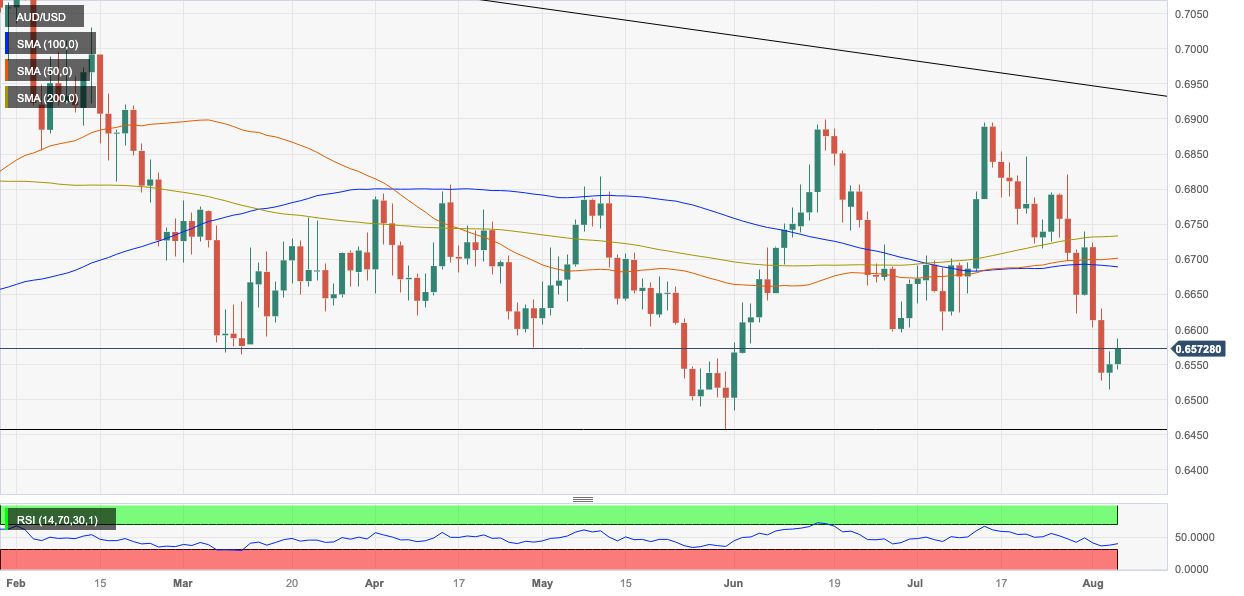Australian Dollar extends rally after NFP report misses estimates
Share: Australian Dollar rallies versus the US Dollar on Friday after Nonfarm Payrolls misses expectations. The Aussie had already been recovering after markets adopted a risk-on mode reflected in rising Asian stock indices. AUD/USD found a floor at 0.6514 on Thursday and then recovered on the back of upbeat Australian trade data and

- Australian Dollar rallies versus the US Dollar on Friday after Nonfarm Payrolls misses expectations.
- The Aussie had already been recovering after markets adopted a risk-on mode reflected in rising Asian stock indices.
- AUD/USD found a floor at 0.6514 on Thursday and then recovered on the back of upbeat Australian trade data and Chinese services PMIs.
The Australian Dollar (AUD) rebounds against the US Dollar (USD) on Friday, after Nonfarm Payrolls (NFP) data shows the US added 187K new jobs in July, undershooting estimates of 200K. The data suggests a slowdown in the labor market, which could undermine stubbornly high inflation and eventually lead to lower interest rates — negative for USD.
The Aussie had already been rising on the back of an improvement in investor sentiment reflected in the rise in Hong Kong’s Hang Seng and Nasdaq e-mini futures.
AUD/USD trades half a percent higher in the upper 0.65s during the US session.
Australian Dollar news and market movers
- The Australian Dollar quickens its rally against its US counterpart after the latter weakens on below-estimates Payrolls data.
- NFP in July came out at 187K, below estimates of 200K. June’s 209K was also revised down to 185K.
- Other data within the labor report was more positive, taking the venom out of the headline miss: Average Hourly Earnings rose 0.4% MoM and 4.4% YoY – beating expectations in both cases, and keeping up the performance of the previous month.
- The Unemployment Rate fell to 3.5% from 3.6% when no-change had been forecast.
- Average Weekly Hours fell to 34.3 from 34.4 when no-change had been forecast. The decline suggests a larger proportion of the new jobs may have been part-time.
- Labor Force Participation remained the same at 62.6% and Underemployment fell marginally to 6.7% from 6.9%.
- Overall the NFP report suggests there will be less upwards pressure on inflation and the Federal Reserve will not have to adopt as aggressive a strategy as thought to bring it down. This may put a cap on interest rates in the future. Since lower interest rates attract comparatively less foreign capital inflows, they are negative for the US Dollar (positive for AUD/USD).
- The Aussie had already been recovering as the Hang Seng stock index registered an over 1.5% rise early Friday and Nasdaq e-mini futures traded up 0.5% in the pre-market, according to CNBC.
- The battered Australian Dollar found a floor on Thursday after the release of the Australian Trade Balance in June beat expectations of 11,000M with an $11,321M print. This is also higher than the $10,497M in May.
- China Caixin Services PMI in July also beat expectations of 52.5 after coming out at 54.1, from 53.9 in the previous month of June. As Australia’s largest trading partner this is good news for the Aussie.
- Australia’s largest export Iron Ore, however, continues its downtrend, giving the Australian Dollar a headwind. Chinese Iron Ore (62%) Futures took a step down to $104 per tonne on Friday from $107 on the previous day.
- The Australian Dollar has been on a weak footing since the RBA left the policy rate unchanged at 4.1% on Tuesday morning, against the market expectation for a 25 basis point hike. In the policy statement, the RBA explained that the decision to hold rates unchanged would provide them more time to assess the impact of policy tightening to date and the economic outlook.
- That said, they did not completely rule out the possibility of more rate hikes in the future, “Some further tightening of monetary policy may be required to ensure that inflation returns to target in a reasonable timeframe, but that will depend upon the data and the evolving assessment of risks,” the RBA noted.
Australian Dollar technical analysis
AUD/USD is in a sideways trend on both the long and medium-term charts. The February high at 0.7158 is a key hurdle, which if vaulted, will alter the outlook to one that is more bullish longer term.
The 0.6458 low established in June is a key level for bears, which if breached decisively, would give the chart a more bearish overtone. Price is currently moving down nearer to this key low.
Australian Dollar vs US Dollar: Weekly Chart
Price has now broken cleanly through the confluence of moving averages (MA) close to 0.6700, made up of most of the major SMAs – the 50-week, 50-day and 100-day. The breaching of this key support and resistance level is a bearish sign.

Australian Dollar vs US Dollar: Daily Chart
It is possible price may have completed a Measured Move pattern or three wave ABC correction (see daily chart), in July. If so, there is a chance it may be about to start a short-term upcycle.
AUD/USD has now also broken below the 0.6600 June lows on an intraday basis, and a continuation down to the key May lows at 0.6460, is quite possible. A decisive break below them would open the way for a move down to 0.6170 and the 2022 lows.
Because the pair is in a sideways trend overall it is unpredictable and the probabilities do not favor either bears or bulls overall – nor is the Relative Strength Index (RSI) providing much insight on either timeframe.
In technical terms, a ‘decisive break’ consists of a long daily candlestick, which pierces cleanly above or below the critical level in question and then closes near to the high or low of the day. It can also mean three up or down days in a row that break cleanly above or below the level, with the final day closing near its high or low and a decent distance away from the level.
NonFarm Payrolls FAQs
Nonfarm Payrolls (NFP) are part of the US Bureau of Labor Statistics monthly jobs report. The Nonfarm Payrolls component specifically measures the change in the number of people employed in the US during the previous month, excluding the farming industry.
The Nonfarm Payrolls figure can influence the decisions of the Federal Reserve by providing a measure of how successfully the Fed is meeting its mandate of fostering full employment and 2% inflation.
A relatively high NFP figure means more people are in employment, earning more money and therefore probably spending more. A relatively low Nonfarm Payrolls’ result, on the either hand, could mean people are struggling to find work.
The Fed will typically raise interest rates to combat high inflation triggered by low unemployment, and lower them to stimulate a stagnant labor market.
Nonfarm Payrolls generally have a positive correlation with the US Dollar. This means when payrolls’ figures come out higher-than-expected the USD tends to rally and vice versa when they are lower.
NFPs influence the US Dollar by virtue of their impact on inflation, monetary policy expectations and interest rates. A higher NFP usually means the Federal Reserve will be more tight in its monetary policy, supporting the USD.
Nonfarm Payrolls are generally negatively-correlated with the price of Gold. This means a higher-than-expected payrolls’ figure will have a depressing effect on the Gold price and vice versa.
Higher NFP generally has a positive effect on the value of the USD, and like most major commodities Gold is priced in US Dollars. If the USD gains in value, therefore, it requires less Dollars to buy an ounce of Gold.
Also, higher interest rates (typically helped higher NFPs) also lessen the attractiveness of Gold as an investment compared to staying in cash, where the money will at least earn interest.
Nonfarm Payrolls is only one component within a bigger jobs report and it can be overshadowed by the other components.
At times, when NFP come out higher-than-forecast, but the Average Weekly Earnings is lower than expected, the market has ignored the potentially inflationary effect of the headline result and interpreted the fall in earnings as deflationary.
The Participation Rate and the Average Weekly Hours components can also influence the market reaction, but only in seldom events like the “Great Resignation” or the Global Financial Crisis.
.
لینک منبع : هوشمند نیوز
 آموزش مجازی مدیریت عالی حرفه ای کسب و کار Post DBA آموزش مجازی مدیریت عالی حرفه ای کسب و کار Post DBA+ مدرک معتبر قابل ترجمه رسمی با مهر دادگستری و وزارت امور خارجه |  آموزش مجازی مدیریت عالی و حرفه ای کسب و کار DBA آموزش مجازی مدیریت عالی و حرفه ای کسب و کار DBA+ مدرک معتبر قابل ترجمه رسمی با مهر دادگستری و وزارت امور خارجه |  آموزش مجازی مدیریت کسب و کار MBA آموزش مجازی مدیریت کسب و کار MBA+ مدرک معتبر قابل ترجمه رسمی با مهر دادگستری و وزارت امور خارجه |
 مدیریت حرفه ای کافی شاپ |  حقوقدان خبره |  سرآشپز حرفه ای |
 آموزش مجازی تعمیرات موبایل آموزش مجازی تعمیرات موبایل |  آموزش مجازی ICDL مهارت های رایانه کار درجه یک و دو |  آموزش مجازی کارشناس معاملات املاک_ مشاور املاک آموزش مجازی کارشناس معاملات املاک_ مشاور املاک |
برچسب ها :AUDUSD ، Australia ، Australian ، Dollar ، Estimates ، extends ، Fundamental Analysis ، Misses ، NFP ، Rally ، Report ، Technical analysis
- نظرات ارسال شده توسط شما، پس از تایید توسط مدیران سایت منتشر خواهد شد.
- نظراتی که حاوی تهمت یا افترا باشد منتشر نخواهد شد.
- نظراتی که به غیر از زبان فارسی یا غیر مرتبط با خبر باشد منتشر نخواهد شد.





ارسال نظر شما
مجموع نظرات : 0 در انتظار بررسی : 0 انتشار یافته : ۰